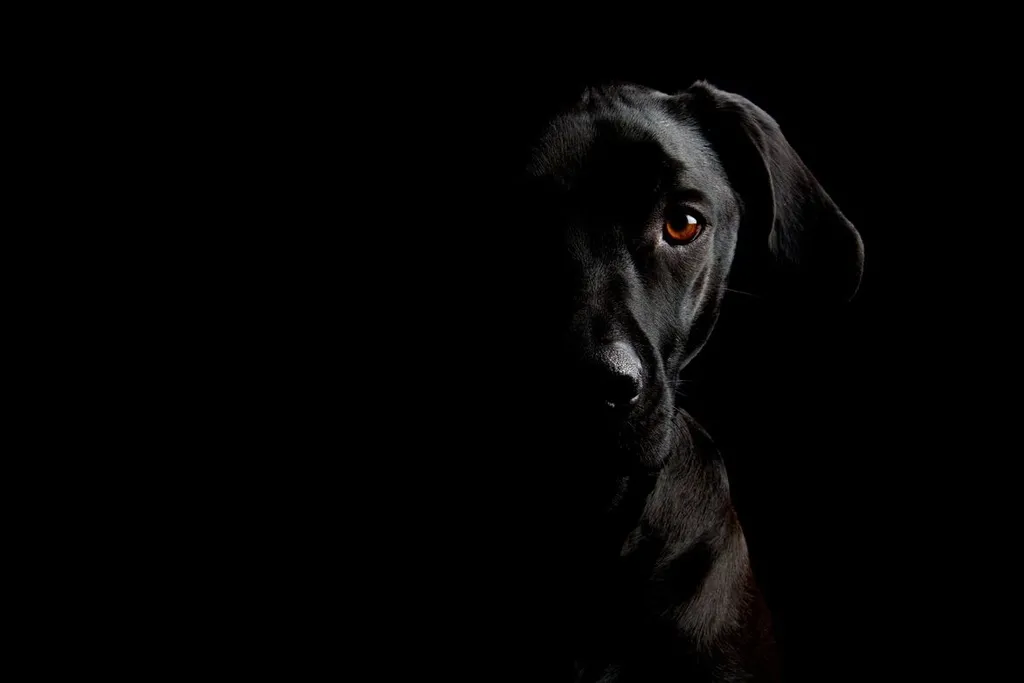When it comes to how dogs perceive the world around them, their vision may differ more than you realize from humans. As any dog owner knows, our canine companions see just fine but the colors they see are more limited than what meets the human eye. Understanding your dog’s actual color vision capabilities and specifically “What Colors Can Dogs Really See?” can optimize how you interact and train with your furry friend.
Let’s take a deeper look into canine color perception and what this knowledge means for strengthening the bond between you and your pup.
Dichromatic Vision versus the Human Spectrum
While humans enjoy vibrant, full-color vision seeing reds, greens, blues, and everything in between, dogs have what is known as dichromatic sight.
They lack one of the three different photoreceptor cone cell types humans possess, severely limiting their color range compared to our own.
Specifically in understanding “What Colors Can Dogs Really See?”, dogs have only blue and yellow/green cones rather than the red, green, and blue cones humans utilize.
Without red and green receptors, dogs cannot perceive those colors as distinct hues. Everything appears to them in varying tones of just blue and yellow, a more muted palette than humans observe
Let’s examine how this impacts the average dog’s daily visual experience:
- Grass and foliage that are vibrant green to us look like a dull yellow to dogs. Autumn leaves transforming from green to their fiery red and orange shades likely just look different yellow tones to Fido.
- Common household objects such as red apples, Stop signs, and fire hydrants blend into their surroundings thanks to an inability to distinguish red.
- While human clothes come in a rainbow of lively colors, dogs see their owners’ shirts as shades of yellow and blue without red or green distinction.
- Even black and white images don’t literally appear that way, as dogs can still see blue and yellow nuances within grayscales. But their reduced range results in a “muted” vision compared to humans.
To illustrate the disparity, this chart compares the photoreceptor cone cell types and perceived color ranges between humans and our canine companions:
| Species | Red Cones | Green Cones | Blue Cones | Perceived Colors |
|---|---|---|---|---|
| Humans | Present | Present | Present | Red, Green, Blue Full Spectrum |
| Dogs | Absent | Absent | Present | Blue, Yellow Dichromatic |
Clearly there exists a gap between the spectrum humans see and what our dogs can perceive through their vision. Now that we understand this limitation, how can we apply this knowledge for the benefit of our pups?
Practical Applications of Color Vision Awareness
Comprehending that dogs live in a blue and yellow world rather than our multicolor one gives insights applicable when living and interacting with man’s best friend. A few examples:
Training Cues
For commands involving hand signals or visual markers, utilize high-contrast colors your dog can distinguish like blue and yellow rather than harder-to-see red and green. Blue training flags pop more against a yellow field than the reverse.
Finding Objects
Don’t rely on dogs seeing a red ball or toy when it blends into fall leaves, picnic blankets or lawns appearing as one yellow surface to them. Opt for colors standing out from backgrounds.
Safety Equipment
Since dogs lack red receptor cells altogether, a red leash or collar has little visibility benefit. Instead, reflective or luminous strips aid nighttime sight beyond just color alone.
Obstacle Courses
For agility training, alternate blue and yellow equipment so jumps, tunnels and other barriers contrast against flooring or matting in trials. Pups navigate courses faster if cues are maximally visible.
Behavior Cues
Mimicking a dog’s blue-yellow vision might reveal body language signals previously missed before as they perceive them, optimizing communication.
Enrichment Toys
Rotating between blue and yellow toys challenges dogs’ natural foraging instincts as one hue blends into surroundings another pops from. Mental stimulation through visual changes boosts well-being.
Taking a dog’s natural visual limitations into account enhances these and other shared activities through clearer, more striking signals within their restricted color perception range. Let’s delve deeper into the science behind canine color vision.
Photoreceptor Physiology and Genetic Basis
As mentioned, dogs lack the cone photoreceptor cells sensitive to long-wavelength red and medium-wavelength green light that give humans trichromatic vision spanning the rainbow. Instead, they possess only short-wavelength blue cones and medium-wavelength green/yellow cones in their retinas.
These cones, like human ones, contain pigment molecules optimized to capture precise wavelengths. But rather than red, green and blue pigments, dogs evolved with only blue and yellow/green pigment variants due to genetic mutations in ancestral canines.
Specifically, dogs lack functional copies of X-chromosome linked color vision genes that encode for red and green cone photopigments, rendering red and green perceptual abilities nonexistent.
Blue and yellow pigment formation still function normally thanks to other photopigment genes intact.
An inquiry into the molecular mechanisms behind such differences illuminates how evolution shaped divergent but appropriate vision for each species’ ecological niche via genetic modification over eons.
It also reveals why dogs perceive light in such a reduced subset of the spectrum we enjoy.
Variations Between Breeds
While all domestic dogs share the common dichromatic trait, recent scrutiny uncovered subtle inter-breed variations in color vision ability.
Researchers at the University of Helsinki studied a sample of 50 herding and 50 non-herding purebreds to quantify any performance differences on color discrimination tasks.
Interestingly, herding dogs like Border Collies performed significantly better at distinguishing between colored objects compared to non-herding types such as bulldogs.
Their superior skills correlated with enhanced blue receptor photoreceptor sensitivity determined by analyzing retinal tissue.
This hints that herding breeds possessing sharper eyesight benefited their ancestors when spotting livestock against various backgrounds quickly. Selective pressures molded sight optimizing their tasks over generations.
By comparison, breeds like bulldogs descended from companion and guard roles requiring less acute vision. Besides inherited factors, their anatomical features blocking optimal light reception may also diminish color perception somewhat.
While all dogs remain dichromats seeing in blue and yellow ranges, certain factors predispose some to view the limited spectrum with mild variances in clarity. Even marginal enhancements grant small advantages, indicating evolution tailors abilities to ancestral roles.
Debunking Common Myths
Despite scientific facts, some unfounded beliefs persist regarding canine color vision. Let’s set the record straight on these misnomers:
Myth: Dogs see in black and white. While their palette contrasts to humans, dogs’ vision is classified as dichromatic not monochromatic. They perceive in blues and yellows, not grayscale.
Myth: Dogs cannot detect certain colors at all. While their range excludes red and green, all wavelengths within the blue-yellow spectrum appear discernible, even if indistinct from one another. No color registers as invisible.
Myth: Vision differs in puppies versus adults. Cone photoreceptor cells mature fully by adulthood, and color perception development finishes around 16-20 weeks. Puppies see similarly to adult dogs barring any eye defects.
Myth: It depends which eye is used. Both eyes function identically, receiving unified information processed together in the brain. No evidence suggests separate left/right eye function or capability differences.
Settling misinformation aids understanding dog sight accurately for optimizing relationships and activities shared with our canine friends. Their vision presents specialized rather than limited so appreciating its adaptations fosters deeper respect.
Building Understanding Through Awareness
Whether seen through human eyes or a dog’s dichromatic perspective, the world remains a fascinating panorama. Applying what we’ve covered about canine color vision benefits pet owners, handlers and the dogs themselves in nuanced yet meaningful ways.
Taking time to understand our furry companions’ unique sensory experiences, how evolution molded them, and being mindful during interactions shows we value our bond beyond superficial levels.
With empathy and care, mutual trust and enjoyment thrives between species through such pursuits.
Comprehending dogs dwell in a simplified yet still dynamic blue-yellow landscape reminds humans not to judge canine intellect or quality of life based on our standards.
Their simplified reality enriches them as it does, as our complex ones fulfill us in return. Differences unite rather than divide when appreciated with compassion.
Ultimately, gaining insights cultivates higher-quality relationships where both parties feel valued for traits as well as abilities compared.
Our shared future brightens when cultural humility guides connections across all kinds. With enriched understanding, dogs and owners alike thrive in the spectrum of relationship colors perceivable by both.
Conclusion about What Colors Can Dogs Really See?
In closing, gaining an understanding of a dog’s color vision can unlock new insights into how they experience the world from their perspective. While their palette differs from humans, dogs are still able to perceive colors through their blue and yellow sensing cones.
Learning “What Colors Can Dogs Really See?” shows our canine companions that we value their unique way of seeing just as they value us for who we are.
Adapting our communication methods and cues based on a dog’s color vision abilities further strengthens the bond of trust between human and furry friend alike.
FAQs
Q:What color do dogs see best?
A: Yellow, orange, and green all look a bit yellowish to a dog. Our furry friends see blue well, but purple looks the same as blue to them.
Q:What is the hardest color a dog can see?
A:Gray, brown, yellow and blue
Q:Can dogs see at night?
A:Dogs have rod-dominated retinas that allow them to see well in the dark.










